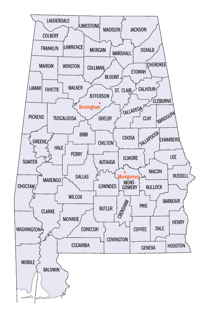Blount County, Alabama History
Blount County Education, Geography, and History
Blount County is a county located in the state of Alabama. Based on the 2010 census, the
population was 57,322. Blount County was created
on Feb. 6, 1818 by the Alabama Territorial legislature, from Montgomery County
and land ceded to the Federal government by the Creek Nation on Aug. 9, 1814.
This county was named in honor of Governor Willie G.
Blount of Tennessee, who assistanced settlers in Alabama during the
Creek War of 1813-14. The county seat is Oneonta.
Etymology - Origin of Blount County Name
Blount county is named for Governor Willie G. Blount of Tennessee, who provided assistance to settlers in Alabama during the Creek War of 1813-14
Demographics:
County QuickFacts: CensusBureau Quick Facts
Blount County History
Blount County, Alabama
Formed by the Alabama Territorial legislature on Feb. 6 in 1818, from land ceded to the Federal government by the Creek Nation on 1814 of Aug. 9. It was named for Gov. Willie G. Blount of Tennessee, who provided assistance to settlers in Alabama during the Creek War of 1813-14. It lies in the northeastern section of the state, generally known as the mineral region.
Blount County is surrounded by Cullman, Marshall, Etowah, Jefferson, and Walker Counties. The county is drained by the Locust and Mulberry Forks of the Black Warrior River. Blount County contains 643 square miles. The Warrior coal field is located in Blount County. From 1818 to 1889, Blountsville served as the county seat. An election that year resulted in its transfer to Oneonta. Other towns and communities include Bangor, Blount Springs, Liberty, and Cleveland.
Blount County is a dry county, with the exception of Oneonta, which allows for the sale of alcohol since 2013. In the November 6, 2012 elections, a
countywide ballot initiative to allow alcohol sales was narrowly defeated.
Blount County has been dubbed the "Covered Bridge Capital of Alabama" since it has more historic covered bridges standing within a single county
than any other in the state - with earlier covered bridges known of. This county celebrates the Covered Bridge Festival every autumn in Oneonta to
commemorate its three remaining covered bridges.
Geography: Land and Water
As reported by the Census Bureau, Blount county has a total area of 651 square miles (1,690 km2), of which 645 square miles (1,670 km2) is land and 5.9 square miles (15 km2) (0.9%) is water.
The Mulberry Fork and Locust Fork, two major tributaries of the Black
Warrior River, run along the western border and the center of the
county. Part of Sand Mountain and Ebell Mountain lie in the northeastern
area of the Blount county.
Neighboring Counties
Bordering counties are as follows:
- Northeast: Marshall County
- East: Etowah County
- Southeast: St. Clair County
- Southwest: Jefferson County; Walker County
- Northwest: Cullman County
Places of interest
Blount County is home to an abundance of outdoor activities, such as Rickwood Caverns State Park and the Locust Fork of the Black Warrior River that are used by canoeists and kayakers. The county is also home to the picturesque covered bridges mentioned above: the Swann Covered Bridge, the Horton Mill Covered Bridge, and the Easley Covered Bridge. As of summer 2009, all three bridges were closed due to safety concerns at the recommendation of the Alabama Department of Transportation. Restorations were completed from 2011 through 2013 and they are once again open.







